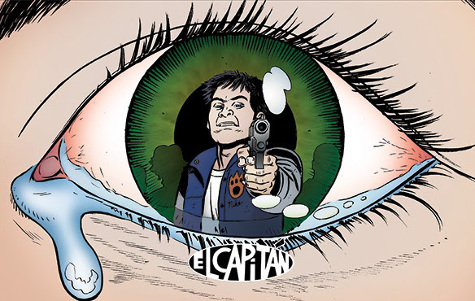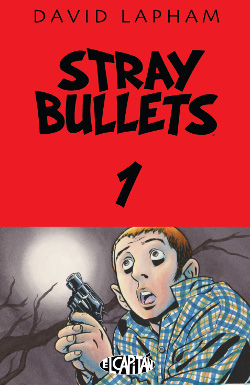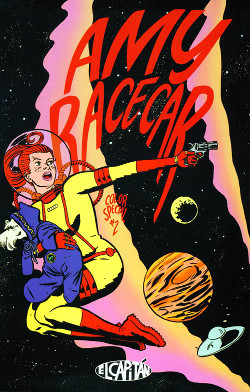
Crime comics are among the most popular genres in mainstream comic books (perhaps only second to superheros). For generations, comic readers have eaten up hardboiled goodness like Sin City and 100 Bullets, titles that have proven there’s much more mainstream appeal in comic books than just seeing grown men wear homoerotic tights. What’s more though, the genre has shown real artistic merit, particularly in one long-running series that is sorely under-read and left off too many contemporary must-read lists: David Lapham’s Stray Bullets.
First published in 1995, Stray Bullets was the bleeding edge of independent comics for its time. Not only did Lapham write and draw the comic entirely himself, but he published it through his own El Capitan Books, allowing him to put out the series the exact way he wanted to. A non-linear crime story that was entirely printed in black-and-white and favored a hefty degree of realism, the series was unlike any other American series at the time (hell, even the design of the TPB’s looked closer to the European standard).
It quickly became a critic’s darling, but less-than-astounding sales diminished Lapham’s output, and in 2005, Lapham found that it was just too expensive for him to keep putting out the book. However, in 2013, a rather unexpected ray of hope peaked through the clouds. Image Comics (publisher of largely popular titles like The Walking Dead and Spawn) bought the rights for the series, allowing Lapham the funds and creative control he needed, and new issues began to hit the stands in March 2014. Since then, new issues of Stray Bullets have been coming out at a fast and consistent rate with no decline in quality.
The publishing history for Stray Bullets alone makes it an anomaly, but anyone whose read an issue of the comic will tell you that it’s a series that deserved its revival. Right from the very first issue, Lapham’s series revealed itself as a masterwork of the genre, with a premiere that’s simply one of the best in comic-book history.
 The first issue tells a haunting crime story set in rural California in 1996 (intriguingly, in the series’ time-jumping narrative, this is currently the most recent year the series has reached) that follows a really bad night for a thuggish man and his naïve younger accomplice. The issue is filled with violence, yet it’s not the kind that bombards you—it gets under your skin and crawls. It’s the type of unglamorous depiction that filmmakers like David Cronenberg and The Coen Brothers have perfected in their best work, and Stray Bullets shows it has an equal place in comic books.
The first issue tells a haunting crime story set in rural California in 1996 (intriguingly, in the series’ time-jumping narrative, this is currently the most recent year the series has reached) that follows a really bad night for a thuggish man and his naïve younger accomplice. The issue is filled with violence, yet it’s not the kind that bombards you—it gets under your skin and crawls. It’s the type of unglamorous depiction that filmmakers like David Cronenberg and The Coen Brothers have perfected in their best work, and Stray Bullets shows it has an equal place in comic books.
That’s just the first issue though! Stray Bullets continues to be a most transgressive series with every single new release, and there simply isn’t another crime comic that feels both as palpable or sensational as Stray Bullets does. Filled with more decadence and low-lifes than a Tom Waits album, Lapham’s world isn’t always a pleasant place to visit, but it’s never one that ceases to astonish.
The characters feel all too real, as being criminals may be a part of their life, but it’s not the whole of it. Just like you and me, Lapham’s characters read comic books, hang out with friends, talk about movies (Star Wars, no less), and partake in less-savory vices such as having promiscuous sex and using illicit substances (Lapham’s artwork for depicting a drug high is also a gold standard for the industry).
This touch of slice-of-life sensibility really augments the violence when it hits, and trust me that it hits hard. While other crime series tend to be more pervasive in their violence (even the similarly lauded Criminal by Ed Brubaker and Sean Phillips), Lapham takes his time getting there, and the pay-off is always insurmountable—especially once you gather how the book’s characters aren’t caricatures.
Which brings us to another trick that Stray Bullets pulls off with full aplomb: telling a resourceful story arc while still allowing for self-contained stories. The series definitely has an ongoing narrative—with recurring characters, locations, and events from other issues being brought up in dialogue—but the books are considerably episodic in their own right. If a reader wished to, they could pick up any issue of Stray Bullets and enjoy it for what it is (especially with the non-linear chronology of the issues), but those that read them issue-by-issue will catch onto certain subtleties.
Lapham clearly likes to provoke thought through unseen plot devices and points of intrigue (e.g., the series’ central crime boss, Harry, is frequently brought up in dialogue, yet we’ve yet to actually see what the character looks like). Also, with some of the horrific fates of his characters having already been revealed, there’s always an elephant in one’s head while reading these preluding chapters.
 That said, the series isn’t all doom and gloom. It actually has a very necessary sense of humor. The most evident of this is through a series of recurring issues that focus on the adventures of Amy Racecar—a fictitious character created within the series by the young and adventurous tomboy Ginney Applejack. The Amy Racecar issues feature bizarre storylines and scenarios that are so ludicrous that they’re hilarious.
That said, the series isn’t all doom and gloom. It actually has a very necessary sense of humor. The most evident of this is through a series of recurring issues that focus on the adventures of Amy Racecar—a fictitious character created within the series by the young and adventurous tomboy Ginney Applejack. The Amy Racecar issues feature bizarre storylines and scenarios that are so ludicrous that they’re hilarious.
While, at first, Amy Racecar may seem simply like an attempt at comic relief, the stories give intriguing insight into the mind of a child. Ginney is a young girl who has seen too much violence in her life, and the savagery she witnesses does make more than inklings into her imagination. It’s honestly one of the most subversive components for a series that has no shortage of ingenuities and a thematic telling of how violence (whether observed or experienced) affects us.
Stray Bullets is simply an American masterpiece that needs to be experienced by appreciators of great storytelling. To read Stray Bullets, one puts themselves in an echelon of crime fiction that’s comparable to television’s The Wire or cinema’s The Friends of Eddie Coyle. It’s a work that transcends its base in genre to being something truly brilliant, unforgettable, and meaningful in the most subversive way. A must-read if ever there was one, and with no decline in quality in recent years, it’s now as perfect a time to start as ever.
